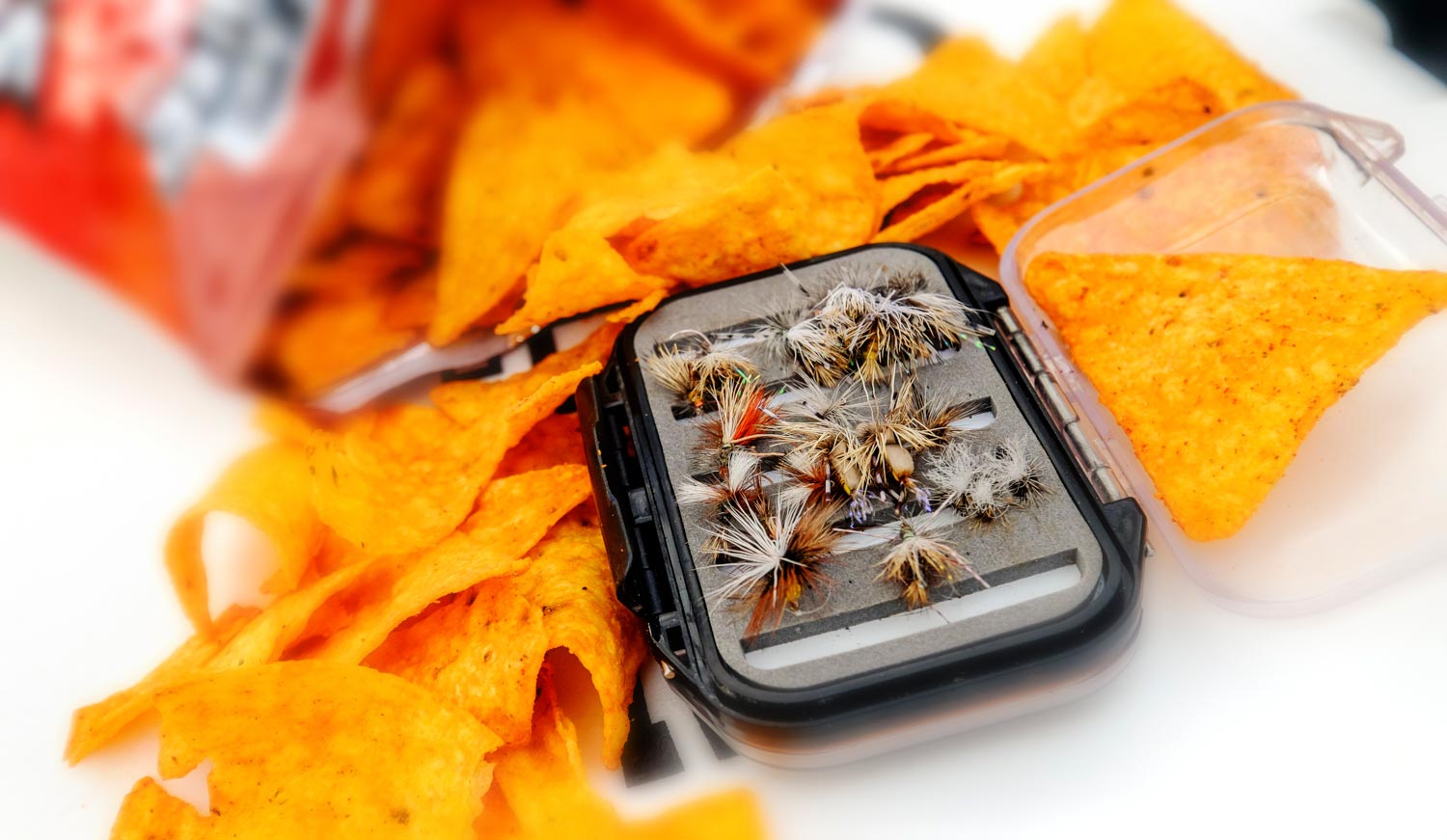By Kyle Wilkinson
What’s more important, fly choice or presentation?
I’ve said it before and I’ll say it again, when it comes to trout fishing (in my opinion) most fish are going to care WAY more about a perfect drift than the exact ‘perfect’ fly- and this is coming from someone who makes a living on the pressured waters of Colorado’s Front Range. The analogy I use for this is with a Doritos chip. See if you can follow me on this one.
You’re hungry and thinking some chinese food sounds pretty good. While waiting on the chinese food to get delivered, someone shows up at your house with a bag of Doritos, opens them up and sets them on the table in front of you. Are you going to eat a few?
I’d say the answer is probably yes.
Even though Doritos might have been the last thing in the world you were thinking about eating, the fact that they were presented in such a way that you: A) had to essentially expend zero effort to eat a few; B) ‘make sense’ as a food source to us; and C) based off of memory taste darn good; the decision to dig in becomes an easy one.
So how does this relate to fly selection, you ask? Simple.
On the waters I fish, throughout the year we see all the standard Western hatches- BWO’s, PMD’s, Caddis, Stoneflies, Tricos, etc. With the wealth of information available online these days, figuring out what bugs are hatching during a certain time of the year has been made pretty simple. What I encourage you all to do – particularly the newer anglers reading this – is to turn down the dial on fly selection and turn up the dial on learning how to fish your flies perfectly.
Right now in Colorado, it is basically a midge and BWO game from a hatch standpoint. Read any local fishing report and you’re going to see many of the same flies being recommended – jujubaetis, Barr’s BWO emerger, Stalcup’s Baetis, Rainbow Warrior, Two-Bit Hooker, Pheasant Tail, etc. (There will also be a bunch of midge recommendations, but for now we’ll focus on the mayfly side of things.) So which one do you use? My answer: whichever you like/gives you the most confidence. On any given day, I feel confident I could hit the water with any of these patterns and catch fish if I fish them well. Do I have my favorites in the string of flies listed above? Sure. Does it match up with all of my fellow guide’s favorites? Nope. If you love a jujubaetis then fish that. Don’t worry about the fact that your buddy swears by the Barr’s BWO. I can’t tell you the number of times I’ve been out fishing with a buddy and we both catch equal numbers of fish while using different patterns. All the flies listed above mimic a small mayfly nymph, and small mayfly nymphs ‘make sense’ as a food source to a trout right now.
Next time you hit the water, fish with some flies that “make sense,” but more importantly, fish them in a way that a trout has to expend little to no effort to consume them, i.e. fish them perfectly. I can assure you this will always lead to more fish throughout the day than getting all worked up over which “exact” fly you should be using.
The best anglers out there aren’t the best because they’re the best at picking which fly to use. They’re the best because they’re the best at fishing whatever fly they choose.
Kyle Wilkinson Gink & Gasoline www.ginkandgasoline.com hookups@ginkandgasoline.com Sign Up For Our Weekly Newsletter!



Reminds me of a coffee mug I saw in MT, “It’s not the fly, you just suck!”
That sounds like MT.
SPOT.ON.
Kyle Wilkinson for prez!
Making America fish again!
BAM!
how true, how true. I’ve noticed that when you get a black, dark gray or dark olive nymph wet they look almost the exact same color. think a trout can see that well that fast? I also fish a parachute ant in several sizes and standard and not so standard colors year round, not all the time, but mostly as a break in the hatch routine. it can work extremely well Please. try it and send some feedback to this blog.I want to hear if it works for you as well as it has for me.
There is one exception to “the presentation” over “fly choice” philosophy. That’s when the fly design allows for a better presentation. Example being dry flies that only float for a few casts before becoming waterlogged and sinking. Bad fly choice. This happens way more than one might expect. So when fly choice affects presentation the answer becomes. “both”
This is a fantastic example. I really like this article and the simplicity that brings out the feeling I always feel when trying to pick the right fly. I can never put this feeling into words but this article does. Great Job.
Pingback: Tippets: Selection vs. Presentation, Interview with Bryan Gregson | MidCurrent
Good point and I agree.
But, I would like hear a little more about what defines a “good presentation” so the novices could take note of the particulars. There is more to it than “just get it close to the fish”.
I guess I agree but disagree with the over simplifacation of preparing for a days fishing. Taking the time to simply observe the water and doing a quick seine to check for whats in the drift and if fish are rising observe what is on the surface. Binoculars are indispensible for this simple tactic. Then the fly selection will pretty much dictate itself in most instances. Then with proper presentation the probability of success are even higher.
Doritos and Chinese Food (delivered): Love the analogy and also…. let’s roll one out of your bag…